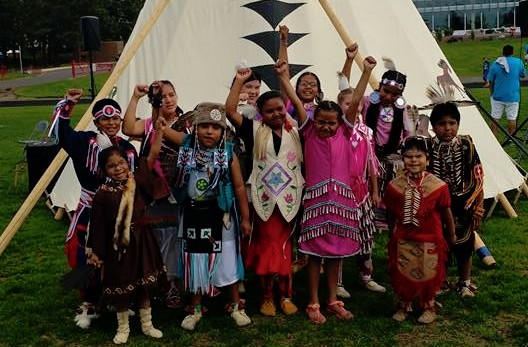
Young members of the Burns Paiute Tribe of Oregon. Photo from Facebook
The Burns Paiute Tribe survived a broken treaty and a forced march so it's no surprise that its leaders are standing up to an armed group that has taken over the Malheur National Wildlife Refuge in Oregon, professor Jim Patterson observes:
Originally the Northern Paiute roamed over much of the Great Basin. Their territory included parts of northern Nevada, northeastern California, southeastern Oregon and southwestern Idaho. Now all they own is a tiny reservation and some small grazing allotments. In the spring, families would camp on Nigger Flat (this name was changed in the fifth edition of the Oregon Historical Society’s “Oregon Geographic Names”) in northeastern Harney County. The women would dig edible roots such as camas. The men would set up their salmon traps on the Drewsey River so they would be ready in the spring run. When the salmon were caught and dried, families would drift off to hunt deer, sage hens and other birds. Ripening seeds would be cached for winter consumption. In mid-July families would gather at Cow Creek, east of Harney Lake. There they would gather crickets, which would be roasted, dried, pounded and put into bags for winter. Groundhogs were caught in July, and currants and berries picked as they ripened. In September and October, families would move north toward Seneca and Canyon City, where the women would pick huckleberries and the men would hunt elk. This centuries-old tradition of hunting and gathering continued until the whites came. The group has had a sad history since then, at least until recently. After white settlement a large reservation was created in 1872 south of Burns. Later it was closed, and many of the Northern Paiutes were moved against their will to the Warm Springs Reservation in Central Oregon and the Yakima Reservation in Washington. Many soon returned to the Burns area and were given their present reservation in 1908. They tried lawsuits over the years to get their land back. The Indian legal annals for the next 50 years are replete with such failed attempts. Finally, in the late 1960s, the “Malheur Band” of the Northern Paiute received $661,488, which came to $734.20 for each tribal member. This was to compensate them for a part of northern Harney County that President U.S. Grant promised them in 1872, but which Congress failed to approve.Get the Story:
Jim Patterson: Paiute tribe preserves its culture against odds (The Eugene Register-Guard 1/12) More Opinions:
Editorial: Malheur protesters violate Constitution they seek to protect (The Salem Statesman Journal 1/12)
Editorial: It’s time for Bundys to face a day in court (The St. George Spectrum & Daily News 1/10)
Editorial: Time for real discussion on land management (The Argus Observer 1/10)
Steve Paul: Heed the Paiute in this conflict over Oregon land (The Kansas City Star 1/9)
Editorial: A thug is a thug goes for Oregon occupiers (The Philadelphia Tribune 1/8)
Join the Conversation
Related Stories:Steve Russell: Armed 'patriots' at odds with Burns Paiute Tribe (1/11)
Gyasi Ross: Crazy White people have turned into the new Indians (1/8)
Jacqueline Keeler: Paiute ancestors were forced on Trail of Tears (1/8)
Peter d'Errico: Armed White men invade Indian lands in Oregon (1/8)
Federal agencies closed offices in Oregon amid safety concerns (1/8)
House Democrats call for armed group to leave refuge in Oregon (1/7)
Charlotte Rodrique: Land rightfully belongs to Burns Paiute Tribe (1/7)
Burns Paiute Tribe tells armed group to leave ancestral territory (1/7)
Burns Paiute Tribe not happy with armed group on ancestral land (1/6)
Armed group wants more to join protest on ancestral Paiute land (1/5)
Armed group occupies wildlife refuge near reservation in Oregon (1/4)